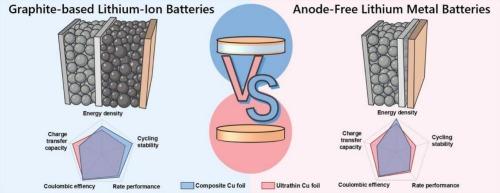用于高能量密度锂电池的铜箔:复合与超薄
IF 8.9
2区 工程技术
Q1 ENERGY & FUELS
引用次数: 0
摘要
锂离子电池(lib)和无阳极锂金属电池(aflmb)对更高能量密度的需求不断增长,推动了轻型集流器(CCs)的探索。传统的铜箔在成本和厚度减少方面面临着严重的限制,需要创新的替代品。复合铜箔已经成为一种很有前途的解决方案,提供超轻设计,正交导电性和固有安全性。然而,它们同时面临着界面不稳定、电子传输效率低下和制造可扩展性不成熟等挑战。本研究系统地比较了pet基复合铜箔(PETCu)与石墨(Gr)基lib和aflmb中的超薄铜箔。PET-Cu表现出更高的抗拉强度和缓冲Gr体积膨胀,尽管其绝缘层增加了界面电阻,但在锂离子电池中循环290次后,容量保留率提高到93.9%。在aflmb中,PET-Cu最初使Li沉积均匀,但由于界面劣化而导致容量迅速衰减。虽然PET-Cu在能量密度方面表现优异,但在电导率和可循环性方面面临着权衡。该研究强调了界面工程和可扩展制造优化复合材料CC设计的必要性。本文章由计算机程序翻译,如有差异,请以英文原文为准。

Copper foils for high-energy-density lithium batteries: Composite vs. ultrathin
The escalating demand for higher energy density in lithium-ion batteries (LIBs) and anode-free lithium metal batteries (AFLMBs) has driven the exploration of lightweight current collectors (CCs). Conventional Cu foils face critical limitations in cost and thickness reduction, necessitating innovative alternatives. Composite Cu foils have emerged as a promising solution, offering ultra-lightweight design, orthogonal conductivity, and intrinsic safety. However, they concurrently face challenges such as interfacial instability, electronic transport inefficiencies, and immature manufacturing scalability. This study systematically compares PET-based composite Cu foils (PET![]() Cu) with ultrathin Cu foils in graphite (Gr)-based LIBs and AFLMBs. PET-Cu shows higher tensile strength and buffers Gr volume expansion, enhancing capacity retention to 93.9 % after 290 cycles in LIBs, though its insulating layer increases interfacial resistance. In AFLMBs, PET-Cu enables uniform Li deposition initially but succumbs to rapid capacity decay due to interfacial deterioration. While excelling in energy density, PET-Cu faces trade-offs in conductivity and cyclability. The study highlights the need for interface engineering and scalable manufacturing to optimize composite CC design.
Cu) with ultrathin Cu foils in graphite (Gr)-based LIBs and AFLMBs. PET-Cu shows higher tensile strength and buffers Gr volume expansion, enhancing capacity retention to 93.9 % after 290 cycles in LIBs, though its insulating layer increases interfacial resistance. In AFLMBs, PET-Cu enables uniform Li deposition initially but succumbs to rapid capacity decay due to interfacial deterioration. While excelling in energy density, PET-Cu faces trade-offs in conductivity and cyclability. The study highlights the need for interface engineering and scalable manufacturing to optimize composite CC design.
求助全文
通过发布文献求助,成功后即可免费获取论文全文。
去求助
来源期刊

Journal of energy storage
Energy-Renewable Energy, Sustainability and the Environment
CiteScore
11.80
自引率
24.50%
发文量
2262
审稿时长
69 days
期刊介绍:
Journal of energy storage focusses on all aspects of energy storage, in particular systems integration, electric grid integration, modelling and analysis, novel energy storage technologies, sizing and management strategies, business models for operation of storage systems and energy storage developments worldwide.
 求助内容:
求助内容: 应助结果提醒方式:
应助结果提醒方式:


